Bird enthusiasts and pet lovers are often drawn to the colorful and charming world of small parrots. Within this realm, two captivating species, the Parrotlet, and the Parakeet, have captured the hearts of many. These feathered companions may appear similar at first glance, but beneath their vibrant plumage lies a world of subtle differences.
In this comparison, we will delve into the unique characteristics of Parrotlets and Parakeets, exploring their traits, behaviors, and suitability as pets. So, let us embark on this avian adventure and uncover the captivating tale of Parrotlet versus Parakeet.
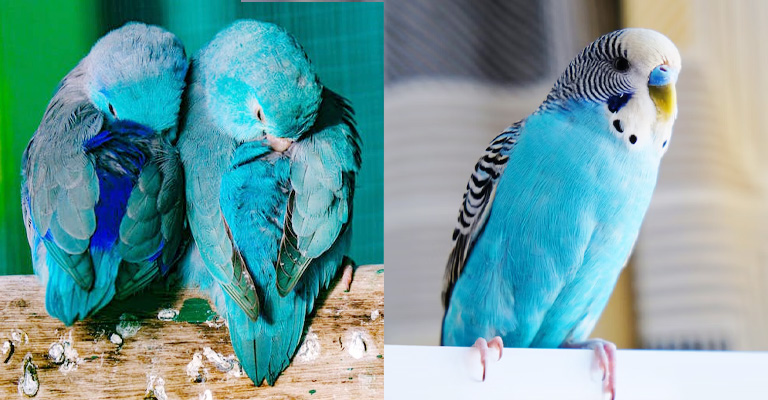
Differences Between Parrotlets and Parakeets
Here Are Some Differences Between Parrotlets and Parakeets
Overall Size
Parrotlets are generally smaller in size compared to parakeets. Parrotlets are considered one of the smallest parrot species, typically measuring around 4.5 to 5.5 inches (11-14 cm) in length from beak to tail. They have a compact and stocky build, giving them a robust appearance.
Parakeets, on the other hand, are generally larger than parrotlets. The size of parakeets can vary depending on the specific species, but they are typically larger than parrotlets. Some parakeet species, like the budgerigar (budgie), can grow up to 7-8 inches (18-20 cm) in length.
Tail Feathers
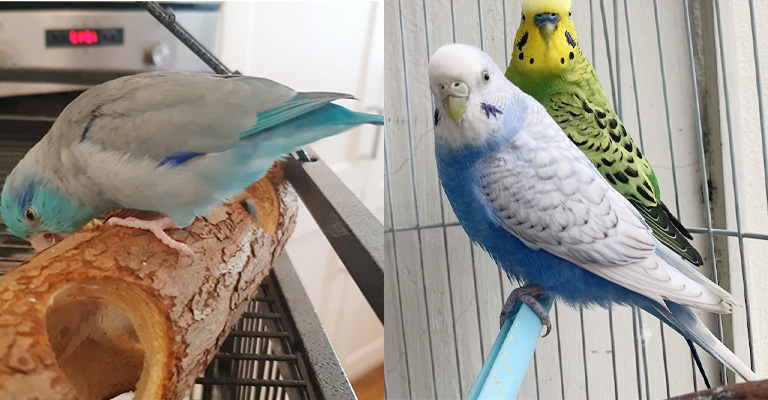
Parrotlets typically have shorter tail feathers compared to parakeets. Their tails are relatively compact and rounded, giving them a stubby appearance. Parrotlets’ tail feathers may have slight variations in shape and length among different species, but they are generally shorter in proportion to their body size.
Parakeets, on the other hand, tend to have longer and more pronounced tail feathers. The length and shape of the tail can vary depending on the specific species of parakeet. In some parakeet species, the tail can be quite long and slender, adding to their graceful appearance during flight.
Beak Size
In terms of beak size, parrotlets, and parakeets also show differences. Parrotlets have relatively small beaks compared to parakeets. Their beaks are short and stout, which is in proportion to their smaller body size. Parrotlets’ beaks are well-suited for their diet, which mainly consists of seeds, fruits, and vegetation.
Parakeets generally have larger beaks in relation to their body size. Their beaks are more elongated and tapering, allowing them to have a greater variety in their diet. Parakeets have a natural tendency to chew and explore their surroundings, and their larger beaks help them in breaking open seeds, nuts, and fruits.
Personality
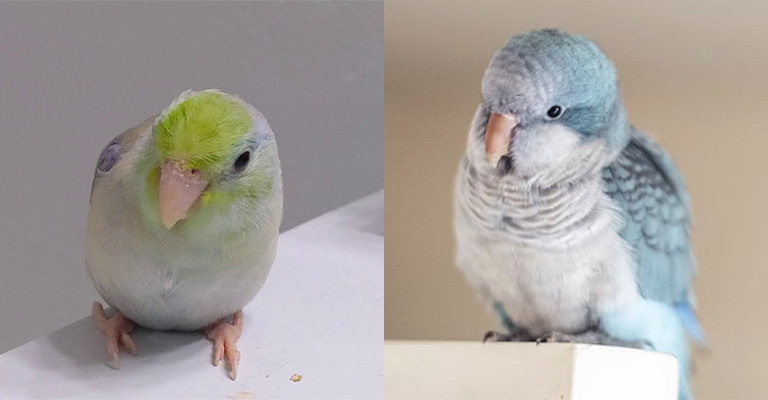
Parrotlets are known for their bold and confident personalities. Despite their small size, they are often described as having a big personality. They are curious, energetic, and can be quite feisty. Parrotlets can be independent and may display a degree of stubbornness at times. They are known to bond closely with their owners and can become quite affectionate and loyal.
Parakeets, on the other hand, are generally known for their sociable and friendly nature. They are often more outgoing and sociable compared to parrotlets. Parakeets are known to be highly intelligent and can be easily trained. They enjoy interaction with their human companions and can be quite playful and entertaining.
Vocalization
Parrotlets are known for their vocalizations, and despite their small size, they have a surprisingly loud and piercing call. They have a wide range of vocalizations, including chirps, squawks, and high-pitched calls. Parrotlets can be quite vocal and may vocalize more frequently when excited or when seeking attention.
Parakeets, particularly budgerigars, are also known for their vocal abilities. They have a wide repertoire of chirps, whistles, and mimicry. Parakeets are highly vocal and can often learn to mimic human speech and various sounds in their environment. They can be quite chatty and may engage in vocalizations for communication, entertainment, and attention-seeking.
Social Needs
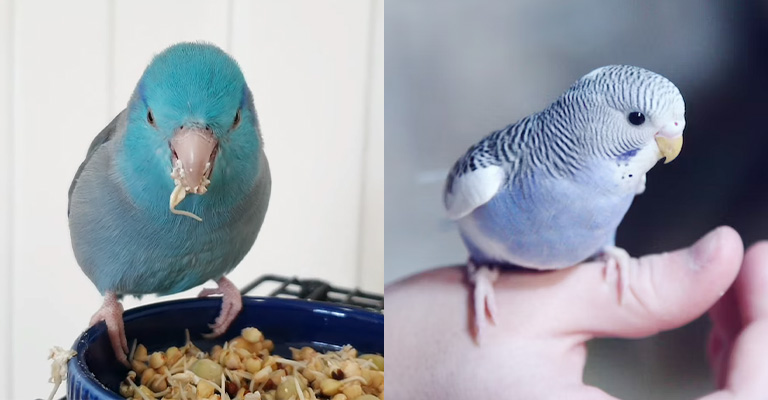
Parrotlets are generally independent birds and can be content with moderate social interaction. While they form strong bonds with their owners, they are also capable of entertaining themselves with toys and activities. Parrotlets may prefer to have a designated safe space in their cage where they can retreat when they need some alone time.
Parakeets, on the other hand, are highly social birds and thrive on social interaction. They are naturally flock animals and need companionship to stay mentally and emotionally healthy. Parakeets often require daily social interaction and mental stimulation. It is recommended to keep parakeets in pairs or small groups to fulfill their social needs.
Flight Needs
Parrotlets have a strong flight instinct and enjoy flying. They benefit from having regular flight opportunities to exercise their wings and maintain their physical health. Parrotlets should have ample space outside of their cage for supervised flight time. They can navigate small spaces quite well due to their compact size and maneuverability.
Parakeets have a higher energy level and require more flying space compared to parrotlets. They have a strong need for flight and should have a larger area available for exercise and exploration. Parakeets are more likely to fly around the room, so it’s important to create a safe environment to accommodate their flight needs.
Cage Size
Due to their smaller size, parrotlets require a smaller cage compared to parakeets. A cage size suitable for a parrotlet should be at least 18×18 inches (45×45 cm) with adequate vertical space for climbing and perching. However, it’s always better to provide the largest cage possible within your available space.
Parakeets require a larger cage to accommodate their need for more physical activity. The recommended cage size for a parakeet should be at least 24×24 inches (60×60 cm) or larger. It should have horizontal bars for climbing, multiple perches, and plenty of space for toys and other accessories.
Energy Level
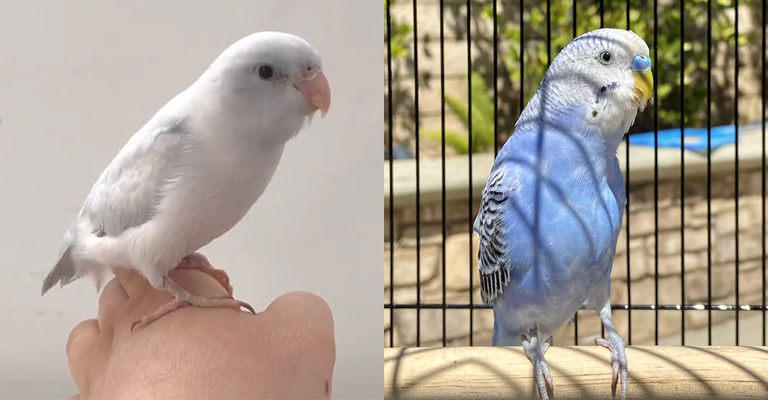
Parrotlets have a moderate energy level. They are active birds that enjoy playtime and mental stimulation. However, they generally have lower energy levels compared to parakeets. Parrotlets can engage in short bursts of activity and play but are also content with quieter periods.
Parakeets have a higher energy level and are known for their lively and active nature. They require more mental and physical stimulation to keep them entertained and prevent boredom. Parakeets benefit from various toys, interactive activities, and opportunities for exploration to burn off their excess energy.
Foraging
Both parrotlets and parakeets have natural foraging instincts. They enjoy exploring and manipulating objects to find their food. Providing foraging opportunities is important for their mental stimulation and to prevent boredom.
Parrotlets have a slightly lower foraging drive compared to parakeets. They may enjoy simple foraging toys or treats hidden in their cage or play area.
Parakeets have a stronger foraging drive and benefit from more complex foraging activities. They enjoy puzzles, foraging toys, and opportunities to search for their food. Offering a variety of foraging options helps keep their active minds engaged.
Habitat
Parrotlets are native to Central and South America, particularly in regions such as Mexico, Ecuador, and Peru. They inhabit a variety of habitats, including forests, savannas, and scrublands. Parrotlets are adaptable and can be found in both arid and tropical environments.
Parakeets, specifically budgerigars, are native to Australia. They are well-adapted to arid and semi-arid regions, such as open grasslands, scrublands, and woodlands. In their natural habitat, parakeets are often found in large flocks, feeding on seeds, grasses, and vegetation.
Color Variations
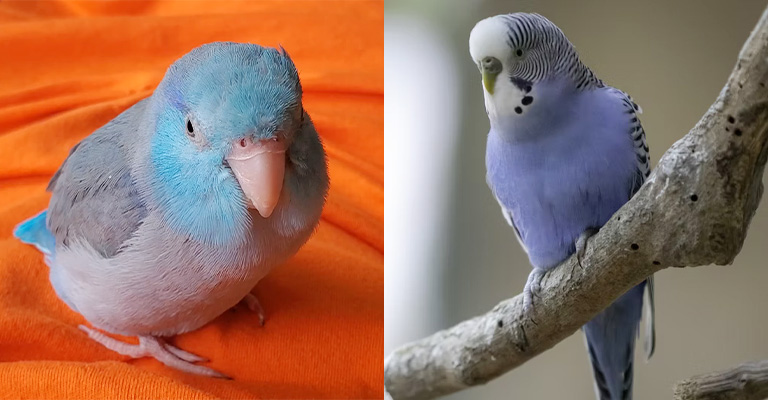
Both parrotlets and parakeets exhibit a wide range of color variations. Parrotlets come in various colors, including green, blue, yellow, and combinations of these colors. Different parrotlet species have distinct colorations, such as the bright blue color of the Pacific parrotlet or the green plumage of the green-rumped parrotlet.
Parakeets, particularly budgerigars, also have diverse color mutations. While wild budgerigars have a green body with yellow face markings, captive-bred budgerigars have been selectively bred to exhibit a wide array of colors, including blue, yellow, white, and even combinations of multiple colors.
Training
Both parrotlets and parakeets are intelligent birds that can be trained to some extent. Parrotlets are known for their strong-willed and independent nature, which can make training more challenging. However, with patience, consistency, and positive reinforcement, parrotlets can learn basic commands and tricks.
Parakeets, including budgerigars, are highly trainable and have a reputation for their ability to mimic human speech and sounds. They are quick learners and can be taught a wide range of tricks and commands through positive reinforcement training.
Nesting Behavior
Parrotlets are cavity nesters, meaning they seek out cavities or hollows in trees to build their nests. In captivity, they can be provided with nest boxes or similar enclosures where they can build their nests and lay their eggs.
Parakeets, including budgerigars, are cavity-nesting birds as well. They typically build their nests in tree hollows or crevices in their natural habitat. In captivity, providing them with nesting boxes or suitable nesting material can encourage their natural nesting behavior.
Lifespan
Parrotlets have a relatively long lifespan for small parrots. On average, parrotlets can live between 15 and 20 years with proper care and nutrition. Some parrotlets have been known to live even longer, reaching up to 25 years or more.
Parakeets, particularly budgerigars, have a similar lifespan to parrotlets. With proper care and a healthy diet, budgerigars can live anywhere between 15 and 20 years. Some budgerigars have been reported to live into their 20s and occasionally even surpass 25 years of age.
Popular Pet Choice
Both parrotlets and parakeets are popular choices as pets, each with its own dedicated fan base. Parrotlets are beloved for their small size, charming personalities, and bold nature. They are often sought after by individuals who prefer a compact parrot with a big personality. Parakeets, particularly budgerigars, are also highly popular pets known for their playful and sociable nature, as well as their ability to mimic sounds and speech.
Availability
Both parrotlets and parakeets are widely available as pets. Parrotlets can be found in pet stores, avian specialty stores, and from reputable breeders. While parrotlets may not be as commonly available as some other parrot species, they can still be obtained with relative ease.
Parakeets, especially budgerigars, are one of the most commonly kept pet birds worldwide. They are readily available in pet stores, breeders, and even from rescue organizations. Their popularity and widespread availability make them easily accessible for prospective pet owners.
Talkativeness
Parrotlets, despite their small size, can be surprisingly talkative. They have a wide range of vocalizations, including chirps, whistles, and occasional mimicry. While parrotlets may not have the same extensive speech capabilities as larger parrots, some individuals can learn a few words or phrases with consistent training and repetition.
Parakeets, particularly budgerigars, are known for their impressive vocal abilities. They have a knack for mimicry and can learn to imitate various sounds and even speech with proper training and exposure. Parakeets are generally more talkative compared to parrotlets and are often sought after by those who enjoy interacting with a bird that can mimic human speech.
Affection
Parrotlets are known to form strong bonds with their owners. They can be affectionate and enjoy spending time with their human companions. While each bird’s personality may vary, parrotlets are often described as loyal and devoted pets.
Parakeets, too, can be affectionate and develop strong bonds with their owners. They are social birds that thrive on interaction and enjoy being part of the family. Parakeets are known to seek attention and can display affectionate behaviors such as preening their owners or snuggling up to them.
Handling
Parrotlets, despite their small size, can be quite feisty and strong-willed. They may require patience and gentle handling to build trust and form a bond with their owners. While they can be handled, some parrotlets may have a preference for being independent and may not always seek physical affection.
Parakeets, on the other hand, are generally more amenable to handling and enjoying physical interaction with their owners. With proper socialization and gentle handling from a young age, parakeets can become comfortable with being held, perching on shoulders, and participating in interactive playtime.
Exercise Needs
Both parrotlets and parakeets have exercise needs that should be met for their physical and mental well-being. Parrotlets require regular flight opportunities outside of their cage to stretch their wings and maintain their health. They also benefit from interactive toys and activities within their cage to keep them mentally stimulated.
Parakeets have a higher energy level and require more exercise and mental stimulation compared to parrotlets. They should have ample space outside of their cage for supervised flight time. Providing a variety of toys, climbing structures, and opportunities for exploration is crucial to keep them physically and mentally active.
How Many Years, On Average, Do Parrotlets And Parakeets Call The Human Population Their Home?
A parrot’s average lifespan is exceptionally long compared to other animals in the animal kingdom. When compared to the lifetime of parakeets, which can last anywhere from five to fifteen years, the average life expectancy of a budgerigar is closer to the lower end of the spectrum.
There is a good chance that larger species of parakeets can survive the winter at higher elevations as well. The rose-ringed parakeet could live for up to 30 years; the larger they get, the longer they live. A parrotlet may live for twenty years. You need to have a lot of dedication if you want to provide appropriate care for these birds.
Which Of These Two Birds, A Parrotlet Or A Parakeet, Requires Less Maintenance Than The Other, And Why Is That The Case?
The choice of a parakeet as a pet bird is suitable for people who are new to keeping birds as pets or have families with more minor children. They have a laid-back attitude and a lovely demeanour, both of which make it a delight to work with them because of how pleasant they are. Because of the forceful personalities of parrotlets, they should never be kept as pets by anyone younger than an adult or by a child who is not mature enough to care for them properly.
Could A Parrotlet And A Parakeet Hold A Conversation With One Another?
Both parrotlets and parakeets have the capability of learning to talk if given the right environment. The males are the only ones able to communicate vocally and mimic a wide range of sounds. Compared to parrotlets, parakeets have a little more developed ability to communicate; their sounds are more comparable to those of people and are easy to understand. Parrotlets, on the other hand, are unable to speak at all.
Parrotlet Vs Parakeet: Comparison Table
| Category | Parrotlets | Parakeets |
| Size | Around 5 inches | Approximately 7 inches |
| Tail feathers | Short and stubby | Long and elegant |
| Beak size | Relatively large | Smaller |
| Personality | Bold and assertive | Social and gregarious |
| Vocalization | Less vocal | Chatty and can mimic sounds and words |
| Social needs | Independent | Highly social and thrive on interaction |
| Flight needs | Active and agile | Active and enjoy flying |
| Cage size | Smaller cage | Larger cage or aviary |
| Energy level | Playful and energetic | Energetic and active |
| Foraging | Enjoy interactive toys and foraging opportunities | Enjoy chewing and exploring |
| Habitat | Tropical forests | Grasslands and open areas |
| Color variations | Limited variations | Wide range of color mutations |
| Training | Intelligent and trainable | Intelligent and trainable |
| Nesting behavior | Build nests in cavities | Build nests in enclosed areas |
| Lifespan | Around 15-20 years | Around 10-15 years |
| Popular pet choice | Increasing popularity | Long-standing popularity |
| Availability | Widely available | Widely available |
| Talkativeness | Less talkative | Chatty and can learn to mimic sounds and words |
| Affection | Form strong bonds with owners | Form strong bonds with owners |
| Handling | Relatively easier to handle | Require careful handling due to their size |
| Exercise needs | Regular exercise and mental stimulation | Regular exercise and flight opportunities |
FAQ
Parrotlets and Parakeets are small parrot species popular as pets, known for their colorful plumage and lively personalities.
Parrotlets are more minor, measuring around 4-5 inches, while Parakeets range from 7-18 inches.
Parrotlets have stockier bodies, short tails, and a more robust beak, while Parakeets have slender bodies, long tails, and a tapered beak.
Parrotlets are known for their aggressive and confident personalities, while Parakeets are generally more social, playful, and vocal.
While both require a balanced diet, clean cages, and mental stimulation, Parrotlets may need more attention and socialization to prevent boredom and aggression.
Parakeets are often recommended for beginners due to their social nature and adaptability, whereas Parrotlets may require more experienced bird owners.
Both species can learn to mimic human speech, although Parakeets are generally considered better talkers due to their more extensive vocabulary.
Parakeets are often more suitable for families due to their sociability, ease of care, and ability to bond with multiple family members.
Conclusion
In the ultimate face-off between the Parrotlet and the Parakeet, we have witnessed a clash of beauty, personality, and charm. While Parrotlets impress with their diminutive size and fierce personalities, Parakeets shine with their vibrant colors and playful nature.
Ultimately, the choice between these delightful avian companions depends on one’s preferences, lifestyle, and level of commitment.
Whichever path you choose, whether you find joy in the compact and confident Parrotlet or the lively and energetic Parakeet, you are sure to embark on a remarkable journey filled with companionship, laughter, and a world of feathered enchantment.
So, take flight and let your heart soar with the Parrotlet or the Parakeet as you unlock the magic of these delightful feathered friends.